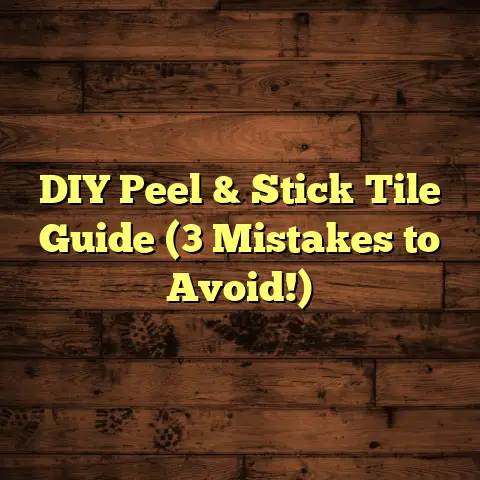Toilet Leak DIY Fix? (Plumber’s Secret!)
Ever had that moment? It’s late, you’re winding down, and then… squish. You step in a puddle around your toilet. Panic sets in, right?
I’ve been there, seen it a thousand times as a flooring and plumbing contractor. Toilet leaks are frustrating, messy, and can feel overwhelming. But guess what? You don’t always need to call a plumber immediately.
In this article, I’m going to pull back the curtain and share some plumber’s secrets to fixing toilet leaks yourself. I’ll break down the types of leaks, how to find them, the tools you need, and step-by-step instructions. Get ready to save some money and gain some serious DIY cred.
Section 1: Understanding Toilet Leaks
So, what exactly is a toilet leak? Simply put, it’s any unwanted escape of water from your toilet system. Now, there’s more than one way a toilet can betray you. Let’s look at the usual suspects:
-
Tank Leaks: These happen in the tank, either from the flush valve (the flapper thing at the bottom), the fill valve (the thing that refills the tank), or cracks in the tank itself.
-
Bowl Leaks: Usually, these are cracks in the porcelain bowl. Sometimes, it can be condensation forming on the outside of the bowl, which isn’t technically a leak but can look like one.
-
Wax Ring Leaks: This is a big one. The wax ring seals the toilet to the flange on the floor. When it fails, you get water seeping out around the base of the toilet. This can damage your flooring and cause mold growth, so it’s important to address it quickly.
-
Supply Line Leaks: This is the hose that connects your toilet to the water supply. Leaks here are usually pretty obvious – you’ll see water dripping from the connection points.
What causes these leaks? Well, it’s usually a combination of wear and tear, age, and sometimes even improper installation. Temperature changes can also play a role, causing parts to expand and contract, which can loosen connections or crack porcelain.
Visual Aid Suggestion: Diagram of a toilet showing the different parts labeled (tank, bowl, wax ring, supply line) and arrows pointing to common leak locations.
Section 2: Identifying the Source of the Leak
Okay, so you know you have a leak. Now the fun begins – finding out where it’s coming from. Don’t worry, it’s not rocket science. Here’s my step-by-step guide:
-
Visual Inspection: Start by looking closely at the toilet, the floor around it, and the walls nearby. Are there any water stains? Is the floor warped or discolored? Look for any signs of water damage.
-
Listen Carefully: Sometimes, you can hear a leak. Listen for a hissing sound, which could indicate a leak in the supply line or the fill valve.
-
The Dye Test: This is a simple but effective way to check for leaks between the tank and the bowl. Drop a few drops of food coloring (any color will do) into the toilet tank. Don’t flush! Wait about 30 minutes. If the colored water appears in the bowl, you have a leak in the flush valve.
-
The Tissue Test: Use a dry piece of toilet paper and run it along the base of the toilet where it meets the floor. If the tissue gets wet, you likely have a wax ring leak. Also, run the tissue along the supply line connections to check for leaks there.
Common Mistakes to Avoid:
-
Assuming the Obvious: Don’t just assume the leak is coming from the most obvious place. Take your time and inspect everything thoroughly.
-
Ignoring Small Leaks: Even a small, slow leak can cause significant damage over time. Don’t ignore it!
-
Not Drying the Area First: Before you start your inspection, dry the area around the toilet completely. This will make it easier to spot fresh leaks.
Personal Story: I once spent hours trying to find a toilet leak, only to discover it was condensation dripping from the tank onto the floor. I felt like a fool, but it taught me the importance of thoroughness!
Section 3: Tools and Materials Needed for DIY Repair
Alright, you’ve found the leak. Now it’s time to gather your arsenal. Here’s what you’ll likely need:
-
Adjustable Wrench: This is your best friend for tightening and loosening nuts and bolts.
-
Pliers: For gripping and holding things in place.
-
Screwdriver (Phillips and Flathead): You’ll need both types for removing and installing screws.
-
Putty Knife/Scraper: For scraping away old wax or caulk.
-
New Wax Ring: Absolutely essential if you’re dealing with a wax ring leak. Get a good quality one!
-
Plumber’s Tape (Teflon Tape): For sealing threaded connections.
-
Bucket and Sponge: For catching water and cleaning up messes.
-
Gloves: Protect your hands!
-
Flashlight: For seeing into those dark, hard-to-reach places.
-
New Supply Line (Optional): If your supply line is old or corroded, it’s a good idea to replace it.
-
Replacement Parts (Optional): Depending on the type of leak, you might need a new flapper, fill valve, or other replacement parts.
Why Having Everything on Hand Matters: Trust me, there’s nothing worse than starting a repair and realizing you’re missing a crucial tool or part. It’ll save you time, frustration, and multiple trips to the hardware store. Prepare beforehand!
Section 4: The Plumber’s Secret: Step-by-Step Repair Guide
Okay, here’s where the rubber meets the road. Let’s get into the nitty-gritty of fixing those leaks. Remember to always turn off the water supply to the toilet before you start any repairs.
4.1 Fixing a Tank Leak
Tank leaks are common, and often, they’re caused by a faulty flapper or fill valve.
Replacing the Flapper:
-
Turn off the water supply: Locate the shut-off valve behind the toilet and turn it clockwise to shut off the water.
-
Flush the toilet: This will empty the tank.
-
Detach the old flapper: The flapper is usually attached to the flush lever with a chain or clip. Disconnect it.
-
Install the new flapper: Attach the new flapper to the flush lever, making sure it’s properly seated over the flush valve opening.
-
Turn the water back on: Slowly turn the water supply valve counterclockwise to refill the tank.
-
Test the flush: Flush the toilet a few times to make sure the new flapper is sealing properly and the leak is gone.
Replacing the Fill Valve:
-
Turn off the water supply and flush the toilet: Same as above.
-
Disconnect the water supply line: Use an adjustable wrench to loosen the nut connecting the supply line to the fill valve. Be prepared for a little water to spill.
-
Remove the old fill valve: There’s usually a nut underneath the tank that holds the fill valve in place. Loosen and remove it.
-
Install the new fill valve: Insert the new fill valve into the tank opening and secure it with the nut underneath.
-
Connect the water supply line: Attach the supply line to the new fill valve and tighten the nut with an adjustable wrench.
-
Adjust the water level: Most fill valves have an adjustment mechanism to control the water level in the tank. Adjust it so the water level is about an inch below the top of the overflow tube.
-
Turn the water back on and test the flush: Same as above.
Sealing Leaks Around Bolts:
Sometimes, the bolts that connect the tank to the bowl can loosen and cause leaks.
-
Tighten the bolts: Try tightening the bolts slightly. Don’t overtighten them, or you could crack the porcelain.
-
Replace the washers: If tightening the bolts doesn’t work, you might need to replace the rubber washers underneath the bolts.
4.2 Fixing a Bowl Leak
Bowl leaks are often caused by cracks in the porcelain. Unfortunately, if the bowl is cracked, the best solution is usually to replace the entire toilet.
Replacing the Toilet:
This is a bigger job, but definitely doable for a DIYer.
-
Turn off the water supply and flush the toilet: Same as above.
-
Disconnect the water supply line: Same as above.
-
Remove the tank (if applicable): If your toilet has a separate tank, disconnect it from the bowl.
-
Remove the toilet from the floor: Remove the bolt caps around the base of the toilet. Use an adjustable wrench to loosen and remove the bolts. You might need to rock the toilet back and forth to break the seal with the wax ring.
-
Scrape away the old wax ring: Use a putty knife or scraper to remove the old wax ring from the flange on the floor.
-
Install the new wax ring: Place a new wax ring on the flange, making sure it’s centered.
-
Position the new toilet: Carefully lower the new toilet onto the wax ring, lining up the bolt holes.
-
Install the bolts and bolt caps: Insert the bolts through the bolt holes and tighten them with an adjustable wrench. Don’t overtighten them! Cover the bolts with the bolt caps.
-
Connect the tank (if applicable): If your toilet has a separate tank, connect it to the bowl.
-
Connect the water supply line: Same as above.
-
Turn the water back on and test the flush: Same as above.
4.3 Replacing the Wax Seal
This is probably the most common toilet repair I do. A bad wax seal can cause a lot of problems.
-
Follow steps 1-5 from “Replacing the Toilet” above.
-
Inspect the Flange: This is the metal or plastic ring that the toilet bolts to. Make sure it’s not broken or corroded. If it is, you’ll need to replace it.
-
Install the New Wax Ring: There are two main types of wax rings: standard wax rings and wax rings with a plastic horn. The horn is designed to help direct water into the drain. Choose the type that’s best for your toilet and flange. Place the new wax ring on the flange, making sure it’s centered.
-
Re-install the Toilet: Carefully lower the toilet onto the wax ring, lining up the bolt holes.
-
Follow steps 8-11 from “Replacing the Toilet” above.
Pro Tip: When you’re lowering the toilet onto the wax ring, try to do it in one smooth motion. Don’t wiggle it around too much, or you could compromise the seal.
4.4 Addressing Supply Line Leaks
Supply line leaks are usually pretty easy to fix.
-
Tighten the Connections: Use an adjustable wrench to tighten the nuts connecting the supply line to the toilet and the water supply valve. Don’t overtighten them!
-
Replace the Supply Line: If tightening the connections doesn’t work, or if the supply line is old or corroded, it’s best to replace it.
-
Turn off the water supply: Locate the shut-off valve behind the toilet and turn it clockwise to shut off the water.
-
Disconnect the old supply line: Use an adjustable wrench to loosen the nuts connecting the supply line to the toilet and the water supply valve. Be prepared for a little water to spill.
-
Install the new supply line: Connect the new supply line to the toilet and the water supply valve, tightening the nuts with an adjustable wrench.
-
Turn the water back on: Slowly turn the water supply valve counterclockwise to turn on the water.
-
Check for Leaks: Inspect the connections for any leaks. If you see any leaks, tighten the nuts slightly.
Industry Jargon: You might hear plumbers talking about “dope” or “pipe dope.” This is a thread sealant that’s used to help create a watertight seal on threaded connections. You can use it on the supply line connections if you want, but it’s usually not necessary if you use plumber’s tape.
Personalized Storytelling: I remember one time, I was called out to a house for a toilet leak. The homeowner had tried to fix it himself, but he had overtightened the supply line connection and cracked the fill valve. I ended up having to replace the fill valve and the supply line. The moral of the story? Don’t overtighten things!
Section 5: Preventative Measures to Avoid Future Leaks
Prevention is always better than cure, right? Here are some tips to keep your toilet leak-free:
-
Regular Inspections: Check your toilet regularly for any signs of leaks, such as water stains or hissing sounds.
-
Replace Worn Parts: Replace worn parts, such as the flapper or fill valve, before they fail completely.
-
Use Quality Materials: When you’re replacing parts, use good quality materials that will last longer.
-
Don’t Use Toilet Bowl Cleaners with Harsh Chemicals: These can damage the rubber parts in your toilet, leading to leaks.
-
Be Careful What You Flush: Only flush toilet paper and human waste. Flushing other items, such as feminine hygiene products or paper towels, can clog the toilet and put stress on the plumbing system.
-
Winterize Your Plumbing: If you live in an area with cold winters, be sure to winterize your plumbing to prevent pipes from freezing and bursting.
-
Check the Water Pressure: High water pressure can put stress on your toilet and other plumbing fixtures. If you have high water pressure, consider installing a pressure reducing valve. According to the EPA, ideal water pressure for homes is between 40 and 60 psi. (Source: EPA Water Efficiency Management Guide)
Conclusion
So, there you have it – the plumber’s secrets to fixing toilet leaks yourself. I know it can seem intimidating at first, but with a little knowledge and the right tools, you can tackle most toilet leaks without calling a professional.
Remember to take your time, be thorough, and don’t be afraid to ask for help if you get stuck. And most importantly, don’t be afraid to get your hands dirty! There’s a certain satisfaction that comes from fixing something yourself.
Now go forth and conquer those toilet leaks! You got this!





